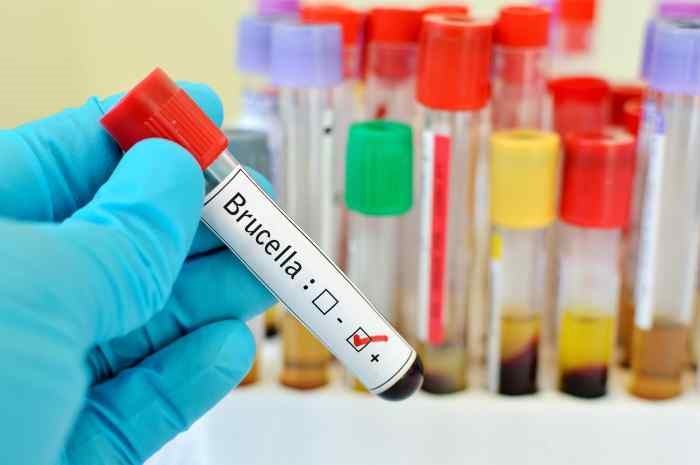
Brucellosis: what it is and what to do
Brucellosis is transmitted from animals to humans and is now easily treated with the appropriate use of antibiotics. Pasteurisation of milk remains the main means of prevention
What causes brucellosis?
Brucellosis (Brucella, Maltese, Mediterranean or Gibraltar Fever) is an infectious animal disease transmissible to humans (zoonosis) caused by bacteria belonging to the genus Brucella.
Humans are accidental hosts and contract this disease from direct contact with an infected animal or through the consumption of infected animal products.
Although brucellosis is widely known as an occupational disease for adults working with livestock, most cases in children are due to food transmission and are associated with the consumption of unpasteurised dairy products.
Brucella abortus (cattle), Brucella melitensis (sheep and goats), Brucella suis (pigs) and Brucella canis (dogs) are the most common microorganisms responsible for human disease.
These bacteria are mainly transmitted by ingestion of contaminated meat or dairy products, inoculation through cuts or skin abrasions, contact with the lacrimal sac, or inhalation of infectious aerosols.
The risk of infection depends on the nutritional and immune status of the host, the route of inoculation and the Brucella species (Brucella melitensis and Brucella suis tend to be the most virulent).
Brucellosis manifests itself with non-specific symptoms
It can be very difficult to diagnose in children if there is no knowledge of exposure to contaminated animals or food.
Symptoms may be acute or more frequently occur insidiously, after an incubation period of 2-4 weeks.
Although symptoms are variable, the classic triad of fever, arthralgia/arthritis and enlargement of the liver and spleen (hepatosplenomegaly) can be demonstrated in many patients.
Other associated symptoms include abdominal pain, headache, diarrhoea, rash, night sweats, weakness (asthenia), vomiting, cough and sore throat.
Food refusal, feelings of weakness and failure to gain weight and height are particularly common in children.
Routine blood tests are not useful, as they can only show non-specific abnormalities such as anaemia, low platelet count (plateletopenia) and low white blood cell count (neutropenia) or pancytopenia, i.e. low numbers of all blood cells.
The most commonly used diagnostic tests are serological tests, which identify antibodies against Brucella abortus, Brucella melitensis, and Brucella suis, while they are not reliable for Brucella canis, although they may show false negatives in the early stages of infection and cross-reactivity with other microorganisms.
C-reactive protein (PCR) (molecular diagnostic test) can be performed on blood or other body tissues and can show positivity as early as 10 days after inoculation.
However, the definitive diagnosis is only made by culture, i.e. by isolating the micro-organism in blood, biological fluids (urine, CSF, synovial or pleural fluid) or tissue (bone marrow or liver biopsy).
Treatment is based on prolonged combined antibiotic therapy, prescribed by the specialist.
The antibiotics used in children aged 8 years or older are Doxycycline with the addition of Rifampin/Streptomycin/Gentamicin, to be administered for a total of 6 weeks.
Treatment for children under 8 years of age consists of Trimethoprim + Sulfamethoxazole (Cotrimoxazole) in combination with Rifampicin, given for 6 weeks.
In the case of organ involvement (heart, central nervous system, bone), treatment is intensified in terms of drugs administered and overall duration.
Pasteurisation of milk and milk products for human consumption remains an essential tool for prevention, as well as avoiding contact with tissues or liquids from infected cattle, goats and pigs.
Brucellosis: no vaccine for human use currently exists
Health education continues to play a prominent role in the prevention of this disease.
Before the use of antibiotics, the course of brucellosis was often prolonged and could end in death. Following the introduction of antibiotic therapy, the prognosis is excellent.
However, there is a possibility of relapse (5-15%), which generally occurs within the first six months after the end of treatment.
Causes of relapse include an inadequate antibiotic regimen, insufficient duration of treatment or the presence of localised foci of infection. Rarely, antibiotic resistance is present.
Mortality from brucellosis is low (around 2%) and is largely due to organ involvement (e.g. endocarditis or severe central nervous system involvement) in complicated cases.
Read Also
Emergency Live Even More…Live: Download The New Free App Of Your Newspaper For IOS And Android
Toxoplasmosis: What Are The Symptoms And How Transmission Occurs
Toxoplasmosis, The Protozoan Enemy Of Pregnancies
Managing Chickenpox In Children: What To Know And How To Act
Monkeypox Virus: Origin, Symptoms, Treatment And Prevention Of Monkey Pox
Leptospirosis: Transmission, Diagnosis And Treatment Of This Zoonosis
Parasitoses And Zoonoses: Echinococcosis And Cystic Hydatidosis
Toxocariasis: The Zoonosis Transmitted By The Nematodes Toxocara Canis Or Toxocara Cati
Streptococcal Infections: The Antistreptolysin Titre (TAS Or ASLO)



